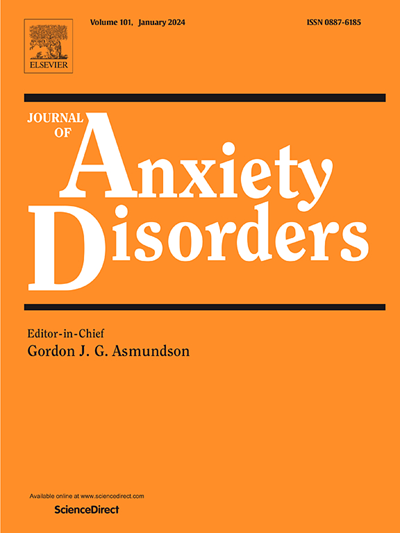What is the internal structure of intolerance of uncertainty? A network analysis approach
IF 4.5
2区 医学
Q1 PSYCHIATRY
引用次数: 0
Abstract
Background
Intolerance of uncertainty (IU) is a well-established risk factor for anxiety disorders, as higher levels of IU increase the likelihood of future maladaptive outcomes. However, the presence of low levels of IU does not imply that maladaptive outcomes will not occur, as other risk factors can still lead to the onset of anxiety symptoms. Currently, it is unknown whether IU also serves as a necessary cause for anxiety symptoms, meaning that its absence would ensure the absence of these symptoms.
Methods
A sample of 186 adolescents (58.6 % boys) between 14 and 18 years of age (M = 16.58 ± 1.01) was followed for six months, with evaluations every three months. Several self-reports were administered to measure IU and general anxiety problems, derived from the Youth Self Report 11–18, and anxiety-specific symptoms, derived from the Self-Administered Psychiatric Scales for Children and Adolescents. The Necessary Condition Analysis approach was applied to determine the extent to which IU is a necessary condition for anxiety.
Findings
The analyses revealed that IU is a necessary condition for anxiety problems (d =.23 −.24), generalized anxiety disorder symptoms (d =.18 −.19), social anxiety disorder symptoms (d =.19 −.29), and school-related anxiety symptoms (d =.19 −.23) after three and six months. However, IU was not a statistically significant necessary condition for separation anxiety disorder symptoms. At baseline, between 29 % and 70 % of the sample exhibited the necessary levels of IU to potentially experience subclinical anxiety symptoms at subsequent follow-ups.
Discussion
IU is a necessary condition for the potential development of anxiety symptoms during adolescence. Recognizing necessary conditions for anxiety symptoms and mental disorders, in general, could lead to substantial progress, given its impact on enhancing our theoretical understanding and improving prevention strategies and clinical treatments.
对不确定性的不容忍的内部结构是什么?网络分析方法
不确定性耐受性(IU)是焦虑症的一个公认的危险因素,因为较高的IU水平增加了未来适应不良结果的可能性。然而,低水平IU的存在并不意味着不会发生适应不良的结果,因为其他风险因素仍然可以导致焦虑症状的发作。目前,尚不清楚IU是否也是焦虑症状的必要原因,这意味着它的缺失将确保这些症状的消失。方法对186名14 ~ 18岁青少年(M = 16.58 ± 1.01)进行为期6个月的随访,其中男生占58.6% %),每3个月进行一次评估。一些自我报告被用于测量IU和一般焦虑问题,来自青年自我报告11-18,以及焦虑特异性症状,来自儿童和青少年自我管理精神病学量表。必要条件分析方法被用于确定IU在多大程度上是焦虑的必要条件。结果:分析显示IU是焦虑问题的必要条件(d =。23−.24),广泛性焦虑障碍症状(d =。18−0.19),社交焦虑障碍症状(d =。19−.29),学校相关焦虑症状(d =。3个月和6个月后分别为19 - 0.23。然而,IU并不是分离焦虑障碍症状的有统计学意义的必要条件。在基线时,29% %至70% %的样本在随后的随访中表现出必要的IU水平,可能出现亚临床焦虑症状。iu是青春期焦虑症状潜在发展的必要条件。认识到焦虑症状和精神障碍的必要条件,一般来说,可以带来实质性的进展,因为它对增强我们的理论认识和改进预防策略和临床治疗有影响。
本文章由计算机程序翻译,如有差异,请以英文原文为准。
求助全文
约1分钟内获得全文
求助全文
来源期刊

Journal of Anxiety Disorders
Multiple-
CiteScore
16.60
自引率
2.90%
发文量
95
期刊介绍:
The Journal of Anxiety Disorders is an interdisciplinary journal that publishes research papers on all aspects of anxiety disorders for individuals of all age groups, including children, adolescents, adults, and the elderly. Manuscripts that focus on disorders previously classified as anxiety disorders such as obsessive-compulsive disorder and posttraumatic stress disorder, as well as the new category of illness anxiety disorder, are also within the scope of the journal. The research areas of focus include traditional, behavioral, cognitive, and biological assessment; diagnosis and classification; psychosocial and psychopharmacological treatment; genetics; epidemiology; and prevention. The journal welcomes theoretical and review articles that significantly contribute to current knowledge in the field. It is abstracted and indexed in various databases such as Elsevier, BIOBASE, PubMed/Medline, PsycINFO, BIOSIS Citation Index, BRS Data, Current Contents - Social & Behavioral Sciences, Pascal Francis, Scopus, and Google Scholar.
 求助内容:
求助内容: 应助结果提醒方式:
应助结果提醒方式:


